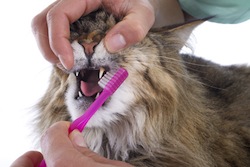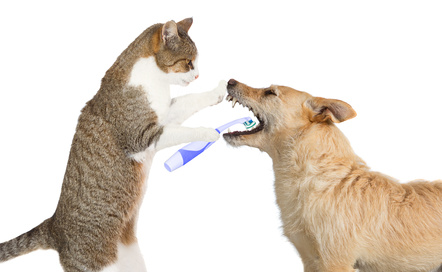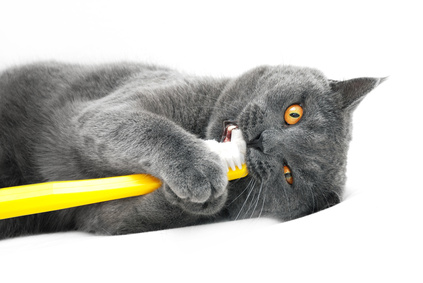Oral care
 Answers to the questions of the quiz
Answers to the questions of the quiz
1) I have to wash my dog's teeth. TRUE/FALSE
True ! It is advisable to accustom your dog from an early age to be
leave brush my teeth. It is the most effective method to avoid the deposit of scale.
A frequency of at least 3 twice a week is recommended, best to do each day !
Your veterinarian can advise you on methods of brushing and the necessary equipment. Conventionally using a toothbrush and toothpaste adapted with good taste and which requires no rinsing obviously !
Place the toothbrush, It is possible to use a finger placed on the index. Then just brush your teeth with your finger, passing under the lips of the dog.
2) Puppies and kittens lose their teeth. TRUE/FALSE
True ! First milk teeth appear around the age of 3 weeks.
Puppies and kittens will then lose their teeth around the age of 3/4 monthly average. Sometimes, you will find their small teeth on the ground but often they swallow. Then come the permanent teeth.
At the age of 6/7 months final dentition is complete. If beyond this age your pet still has milk teeth, It is imperative to consult your veterinarian to check out them : they might hinder the growth of permanent teeth, cause deviations from these, or encourage the filing of scale between milk teeth and permanent teeth.
3) Dogs and cats have no cavities. TRUE/FALSE
Fake ! Just as we, our small companions can suffer from caries. To avoid this it is important to take care of your pet teeth, to control his mouth by a veterinarian regularly and to promptly treat his teeth if the veterinarian observes caries.
4) Poor dental hygiene can cause heart problems in dogs and cats. TRUE/FALSE
True ! The presence of scale causes oral problems : Gingivitis, periodontitis (inflammation of the tissues supporting the teeth, including bone), loosening of teeth... But it can also cause General disorders such as heart or kidney diseases ! The scale contains, Indeed, a very large number of bacteria which can pass into the blood and cause endocarditis (inflammation of the membrane that lines the inside of the Chambers of the heart).
Dental hygiene is therefore paramount as well for the State of the mouth and teeth for the general State of the animal.
5) It is not possible to make descaling in the dog and cat. TRUE/FALSE
Fake ! Decalcifying your vet is possible for your pet. It is easily done and the technique is the same as in humans : the teeth are descaled one by one with a sonicator and polished. The only difference is the need for a small animal anesthesia. After that, your companion emerge with beautiful white teeth and shiny ! You can admire his smile !
6) My pet has bad breath so it must have tartar. TRUE/FALSE
True and false ! It is true that the presence of tartar leads to bad breath.
But if your pet has bad breath, there may also be other causes ! Digestive problems, lesions in the mouth (Gingivitis, ulcers ...), renal failure, liver problems or poor diet can affect your pet's breath !
7) Coryza in cats causes oral problems. TRUE/FALSE
True ! Coryza is due to several pathogens including a viruses called calicivirus very resistant in the external environment and thus very easily contaminant for the cat.
This virus causes Oral lesions (Gingivitis, ulcers of the language…). The cat then suffers pain, difficulties in feeding and drool.
The animal remains very often carrier of the virus and may present chronic oral problems. Where the importance of vaccinating Kitty!
8) The presence of tartar on the teeth of my pet has no connection with the power supply. TRUE/FALSE
Fake ! The presence of tartar on the teeth of dogs and cats is due to some individual factors but also, largely, the quality of food.
Except if there are specific contraindications of your veterinarian (When certain diseases), It is advisable to feed your dog and your cat with cakes rather than a soft diet. Kibbles have an abrasive effect which slows down the deposit of scale.
Furthermore, the quality of the food is paramount. There are such specific croquettes to prevent the deposit of scale : by their composition, they can reduce the formation of scale and promote good oral health !
9) The dog has the same number of teeth that cat. TRUE/FALSE
Fake ! The adult dog 42 teeth so that the adult cat is that 30 !
The dog has on the upper jaw 6 incisors, 2 canines, 8 premolars and 4 molars, and on the lower jaw: 6 incisors, 2 canines, 8 premolars and 6 molars.
The cat has on the upper jaw 6 incisors, 2 canines, 6 premolars and 2 molars, and on the lower jaw: 6 incisors, 2 canines, 4 premolars and 2 molars.
The puppy has 28 milk teeth and the kitten 26.
10) Dogs and cats can have a cleft palate. TRUE/FALSE
True ! As humans, cleft palate are possible in our pets.
The Palace is split in the Middle, longitudinally, What causes a communication between the mouth and nasal cavity. The animal has difficulty feeding (discomfort with swallowing), breathing difficulties, and sometimes ear problems (ear infections).
Cleft palate can be a birth malformation (the veterinarian systematically checks it during the first consultation of a puppy or a kitten) or the result of a big drop, among the "parachute" cats who fall from the balcony of a building ! It is therefore crucial to quickly consult your veterinarian after falling several floors to check the possible appearance of cleft palate and set, If this is the case, the treatment to consider.
Then ? What's your score ? You got 10/10 ? Bravo ! You familiar with the subject and your little companion to 4 legs will be very grateful !


